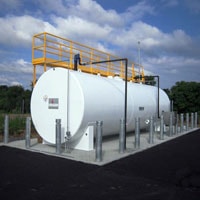Whether due to local regulations or because you are changing out the contents, your aboveground petroleum storage tank will periodically require a cleaning. While it is absolutely crucial that you hire an experienced and licensed storage tank cleaning company to complete the task, it can still be helpful to know what a cleaning entails and how it will be completed. Learn more in this week’s blog.

Pre-cleaning procedures
Before the cleaning will begin, there are a number of tasks that must be completed. First, the crew in charge of the cleaning should conduct a daily on-site meeting to discuss safety issues and potential complications with a representative of the AST owner. This meeting will be documented and then the crew will be responsible for pulling all necessary work permits from the owner. Then a HASP will need to be created that is specific to the site before work is ready to begin.
Aboveground petroleum storage tank cleaning process
Once work is ready to start, a crew of at least 3 people will bring the proper equipment, including a vacuum truck, SCBA system, pressure washers, rescue gear, and more. First, your aboveground petroleum storage tank cleaning crew will set up their secure entry equipment so that the only way to enter and exit the tank will be through manways. An air monitoring meter will be carefully calibrated to check the tank atmosphere and throughout the cleaning process, the tank will be vented. Once the equipment has been set up, the crew will use squeegees to guide recoverable products toward their truck’s vacuum hose. Once this is complete, pressure washers will be used to thoroughly and effectively clean the AST’s interior. The work crew will generally divide the AST into quadrants and carefully clean each section before moving on to the next in order to prevent the contamination of areas that have already been cleaned. Lastly, the vacuum truck will be used to remove contaminated rinse water that will be disposed of properly.